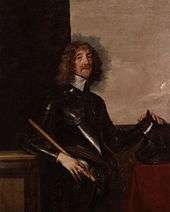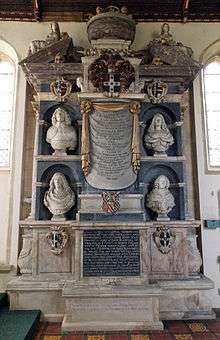Edmund Verney (Cavalier)
Sir Edmund Verney (1 January 1590[1] or 7 April 1596[2] – 23 October 1642) was an English politician, soldier and favourite of King Charles I. At the outbreak of the English Civil War he supported the Royalist cause and was killed at the Battle of Edgehill.


Life
Edmund Verney was the son of Sir Edmund Verney of Pendley Manor near Tring, Buckinghamshire and his third wife Mary Blakeney. He was the grandson of Hon. Elizabeth Verney, second daughter of the first Baron Braye. He had two elder half-brothers Sir Francis Verney who died in 1615, and Ambrose Turvile who died in 1628, and two elder half-sisters on his mother's side, Ann Turvill (who married Sir John Leeke of Edmonton), and Ursula St. Barbe, who married her stepbrother Sir Francis Verney.[3] Knighted by King James I in 1611, Edmund was sent to Madrid, and returned to join the household of Henry Frederick, Prince of Wales, to which his uncle Francis Verney was one of the falconers.[4] Upon Henry's death in 1612, Edmund became a gentleman of the privy chamber to Charles, Duke of York, later Charles I.[1]
From 1620 he made his family home at Claydon House, Middle Claydon, Buckinghamshire (which the Giffard family had held by lease from the Verneys[5]), where he was the near neighbour of Sir Thomas Chaloner of Steeple Claydon.[6] His financial sense was poor, and he was severely indebted by the early 1620s. In 1623, he accompanied Charles and the Duke of Buckingham to Spain to court the Infanta Maria. While there, he protected a dying Englishman from a Catholic priest[1] by punching the priest in the face, which did not endear him to the Spaniards.
Upon his return, he was elected Member of Parliament for Buckingham in 1624, and for New Romney in 1625. After the coronation of Charles that year, he was appointed Knight Marshal of England for life, the duties of which office required him to be extensively at court. He was returned for Aylesbury in 1629. Despite his income from the Knight Marshalsy, several business ventures ended in failure, and his debts were largely unrelieved.[1]
With the approach of the English Civil War, he found himself in a painful conflict. While personally loyal to the King, he resisted the Laudian religious policies. Verney was returned to the Short Parliament and then the Long Parliament as member for Wycombe, and often found himself in opposition to the King.[1]
Upon the outbreak of war, Verney remained true to his master and friend, King Charles, while his eldest son Ralph joined the Parliamentary forces. Made standard-bearer of the royal army, Verney was killed at the Battle of Edgehill. According to the tradition of his family, his body was never identified, except for his severed hand, found still grasping the banner.[1]
Family
He married Margaret Denton, daughter of Sir Thomas Denton of Hillesden, Buckinghamshire[7] on 14 December 1612, with whom he had ten surviving children, including:
- Sir Ralph Verney, 1st Baronet (1613–1696), married Mary Blacknall (1616-165)
- Thomas Verney (1615-1707)
- Sir Edmund Verney (1616–1649) who commanded the Royalist infantry at the Siege of Drogheda and was slain during the final assault (mentioned in Cromwell's letter to John Bradshaw, Esquire, President of the Council of State, dated 16 September 1649).[8]
- Sir Henry Verney (1618-1671)
- John Verney (1619)
- Susannah Verney (1621-51), married Richard Alport
- Penelope Verney (1622-1695), married Sir John Osborne
- Margaret Verney (1623-1667), married Thomas Elmes
- Cary Verney (1626-1704), married firstly Sir Thomas Gardiner and secondly John Stewkeley
- Mary Verney (1628-1684), married Robert Lloyd
- Richard Verney (1629)
- Elizabeth Verney (1633-1721), married Reverend Charles Adams
References
| Wikisource has the text of the 1885–1900 Dictionary of National Biography's article about Verney, Edmund (1590-1642). |
- Whyman, Susan E, ed. (2004). "Verney, Sir Edmund (1590–1642)". Oxford Dictionary of National Biography. Retrieved 17 September 2006.
- "Sir Edmund Verney". Retrieved 17 September 2006.
- W.H. Rylands (ed.), The Visitation of the County of Buckingham made in 1634 by John Philipot and William Riley, Harleian Society Volume LVIII (for 1909) (London 1909), Verney, p.122-23.
- Frances Parthenope Verney, Memoirs of the Verney Family During the Civil War (Longmans, Green & Co., London 1892), Vol. 1, p. 69 ff., at p. 70. A falconer of this name is mentioned in 'An Abstract or brief Declaration of the present State of His Majesty's Revenue' (printed 1651), in Sir Walter Scott (ed.), A Collection of Scarce and Valuable Tracts on the Most Entertaining Subjects, 2nd Edn., 2 Vols (T. Cadell & W. Davies, London 1809), Vol. 1 pp. 364-400, at p. 393.
- 'Parishes : Middle Claydon', in William Page (ed.), A History of the County of Buckingham: Volume 4 (London, 1927), pp. 32-35.. John Broad, Transforming English Rural Society: The Verneys and the Claydons, 1600-1820 (Cambridge University Press, 2004), Chapter 2, 'A gentry family in county and court society 1603-1642', pp. 14-26.
- F.P. Verney, Memoirs of the Verney Family Vol. 1, Chapters 1 and 2, and at p.33-34.
- W.H. Rylands, Visitation of Buckinghamshire
- Thomas Carlyle, Oliver Cromwell's letters and speeches: including the supplement to the first edition,, Volume 1, Harper & brothers, 1868. pp. 380,381
| Parliament of England | ||
|---|---|---|
| Preceded by Richard Oliver Sir Thomas Denton |
Member of Parliament for Buckingham 1624–1625 With: Richard Oliver |
Succeeded by Richard Oliver Sir Alexander Denton |
| Preceded by Francis Fetherston Richard Godfrey |
Member of Parliament for New Romney 1625 With: Richard Godfrey |
Succeeded by Thomas Brett Richard Godfrey |
| Preceded by Clement Coke Arthur Goodwin |
Member of Parliament for Aylesbury 1628–1629 With: Clement Coke |
Succeeded by Parliament suspended until 1640 |
| Preceded by Parliament suspended since 1629 |
Member of Parliament for Wycombe 1640–1642 With: Thomas Lane |
Succeeded by Thomas Lane Richard Browne |